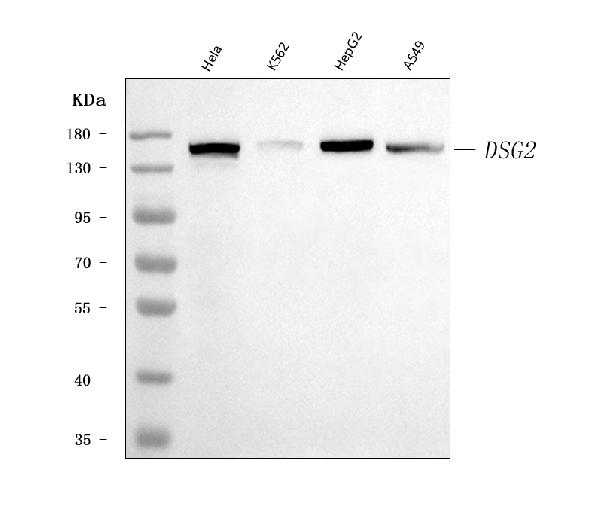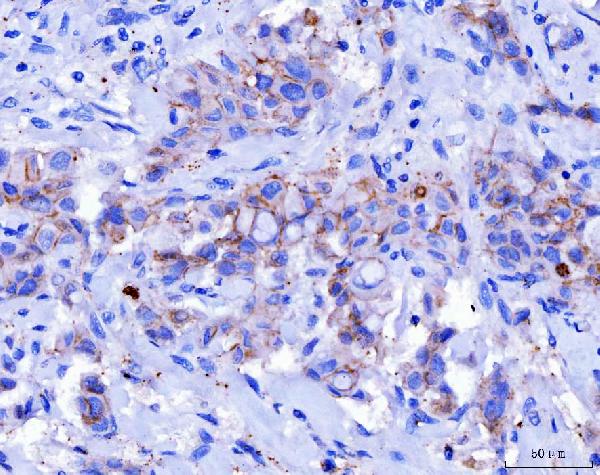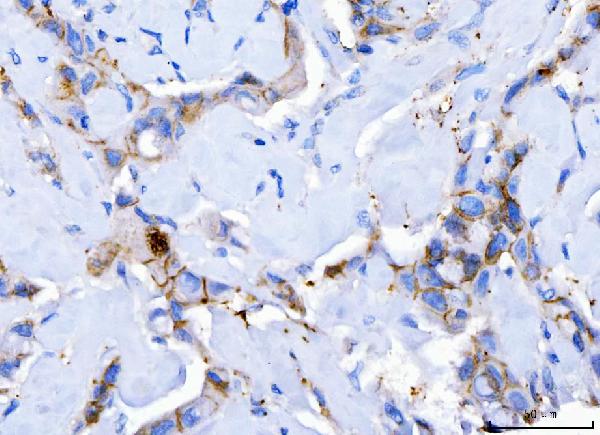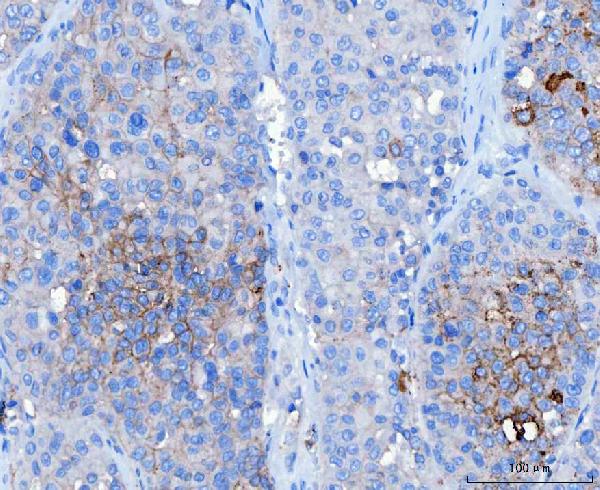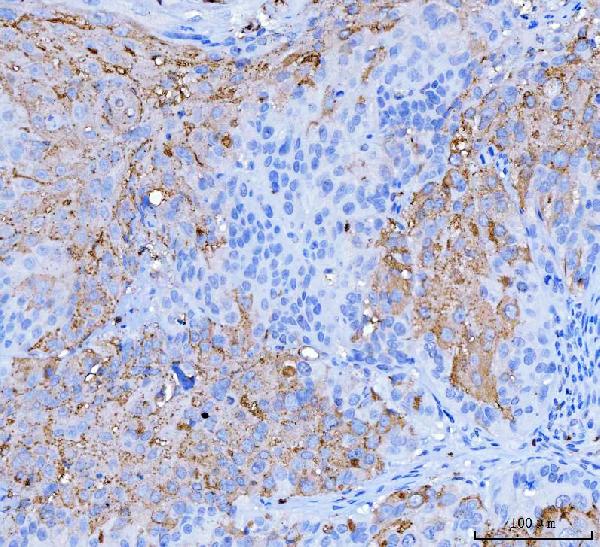Anti-Desmoglein 2/DSG2 Antibody Picoband™ (monoclonal, 2B4D1)
- SPECIFICATION
- CITATIONS
- PROTOCOLS
- BACKGROUND

Application
| WB, IHC |
|---|---|
| Primary Accession | Q14126 |
| Host | Mouse |
| Isotype | IgG1 |
| Reactivity | Human |
| Clonality | Monoclonal |
| Format | Lyophilized |
| Description | Anti-Desmoglein 2/DSG2 Antibody Picoband™ (monoclonal, 2B4D1) . Tested in IHC, WB applications. This antibody reacts with Human. |
| Reconstitution | Adding 0.2 ml of distilled water will yield a concentration of 500 µg/ml. |
| Gene ID | 1829 |
|---|---|
| Other Names | Desmoglein-2, Cadherin family member 5, HDGC, DSG2, CDHF5 |
| Calculated MW | 160 kDa |
| Application Details | Western blot, 0.25-0.5 µg/ml, Human Immunohistochemistry(Paraffin-embedded Section), 2-5 µg/ml, Human |
| Contents | Each vial contains 4 mg Trehalose, 0.9 mg NaCl and 0.2 mg Na2HPO4. |
| Clone Names | Clone: 2B4D1 |
| Immunogen | E.coli-derived human Desmoglein 2/DSG2 recombinant protein (Position: L24-E1020). |
| Purification | Immunogen affinity purified. |
| Storage | At -20°C for one year from date of receipt. After reconstitution, at 4°C for one month. It can also be aliquotted and stored frozen at -20°C for six months. Avoid repeated freezing and thawing. |
| Name | DSG2 |
|---|---|
| Synonyms | CDHF5 |
| Function | A component of desmosome cell-cell junctions which are required for positive regulation of cellular adhesion (PubMed:38395410). Involved in the interaction of plaque proteins and intermediate filaments mediating cell-cell adhesion. Required for proliferation and viability of embryonic stem cells in the blastocyst, thereby crucial for progression of post-implantation embryonic development (By similarity). Maintains pluripotency by regulating epithelial to mesenchymal transition/mesenchymal to epithelial transition (EMT/MET) via interacting with and sequestering CTNNB1 to sites of cell-cell contact, thereby reducing translocation of CTNNB1 to the nucleus and subsequent transcription of CTNNB1/TCF-target genes (PubMed:29910125). Promotes pluripotency and the multi-lineage differentiation potential of hematopoietic stem cells (PubMed:27338829). Plays a role in endothelial cell sprouting and elongation via mediating the junctional-association of cortical actin fibers and CDH5 (PubMed:27338829). Plays a role in limiting inflammatory infiltration and the apoptotic response to injury in kidney tubular epithelial cells, potentially via its role in maintaining cell-cell adhesion and the epithelial barrier (PubMed:38395410). |
| Cellular Location | Cell membrane; Single-pass type I membrane protein. Cell junction, desmosome. Cytoplasm |
| Tissue Location | Expressed in undifferentiated pluripotent stem cells, expression decreases during differentiation (at protein level) (PubMed:29910125). Expressed in hematopoietic stem cells and circulating endothelial progenitor cells, expression decreases upon increasing cell lineage commitment (at protein level) (PubMed:27338829). Expressed on common myeloid progenitors, pro- myelocytes, pro-erythrocytes and B-cell linage progenitors (at protein level). Expression in mature cell types in the bone marrow and mature leukocyte populations is absent (PubMed:27338829). Expressed by foreskin fibroblasts, expression peaks during the early stage of differentiation reprogramming (at protein level) (PubMed:29910125) Expressed by endothelial cells in both arterioles and venules in the cervix (at protein level) (PubMed:27338829). Expressed in kidney tubular epithelial cells (PubMed:38395410) |

Thousands of laboratories across the world have published research that depended on the performance of antibodies from Abcepta to advance their research. Check out links to articles that cite our products in major peer-reviewed journals, organized by research category.
info@abcepta.com, and receive a free "I Love Antibodies" mug.
Provided below are standard protocols that you may find useful for product applications.
Background
Desmoglein-2 is a protein that in humans is encoded by the DSG2 gene. These desmoglein gene family members are located in a cluster on chromosome 18. This second family member is expressed in colon, colon carcinoma, and other simple and stratified epithelial-derived cell lines. Mutations in DSG2 display a high degree of penetrance. Disease expression was of variable severity with LV involvement a prominent feature. The low prevalence of classical ECG changes highlights the need to expand current diagnostic criteria to take account of LV disease, childhood disease expression, and incomplete penetrance.
If you have used an Abcepta product and would like to share how it has performed, please click on the "Submit Review" button and provide the requested information. Our staff will examine and post your review and contact you if needed.
If you have any additional inquiries please email technical services at tech@abcepta.com.













 Foundational characteristics of cancer include proliferation, angiogenesis, migration, evasion of apoptosis, and cellular immortality. Find key markers for these cellular processes and antibodies to detect them.
Foundational characteristics of cancer include proliferation, angiogenesis, migration, evasion of apoptosis, and cellular immortality. Find key markers for these cellular processes and antibodies to detect them. The SUMOplot™ Analysis Program predicts and scores sumoylation sites in your protein. SUMOylation is a post-translational modification involved in various cellular processes, such as nuclear-cytosolic transport, transcriptional regulation, apoptosis, protein stability, response to stress, and progression through the cell cycle.
The SUMOplot™ Analysis Program predicts and scores sumoylation sites in your protein. SUMOylation is a post-translational modification involved in various cellular processes, such as nuclear-cytosolic transport, transcriptional regulation, apoptosis, protein stability, response to stress, and progression through the cell cycle. The Autophagy Receptor Motif Plotter predicts and scores autophagy receptor binding sites in your protein. Identifying proteins connected to this pathway is critical to understanding the role of autophagy in physiological as well as pathological processes such as development, differentiation, neurodegenerative diseases, stress, infection, and cancer.
The Autophagy Receptor Motif Plotter predicts and scores autophagy receptor binding sites in your protein. Identifying proteins connected to this pathway is critical to understanding the role of autophagy in physiological as well as pathological processes such as development, differentiation, neurodegenerative diseases, stress, infection, and cancer.
